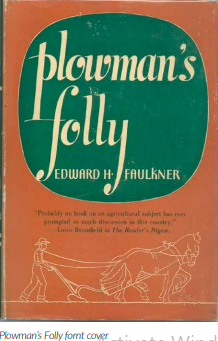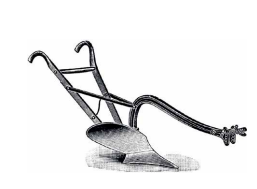By Edward H. Faulkner With a Foreword byS. Graham Brade-Birks M.Sc. (Manc.), D.Sc. (Lond.), of the SouthEastern Agricultural College (University of London), Wye, Kent
First published 1945
Traditions of the Plough
Continued from Issue 1 of Direct Driller
Ploughing done when the furrow slice is plastic creates clods; every clod is so much soil mustered out of service for the season. The tremendous pressure necessary to separate the furrow slice from its base compresses effectively any soil that is moist enough to be plastic; and a moderate amount of clay in plastic soil serves to harden the mass upon drying so that adobe-like clods result. Smoothing implements may reduce the size of these lumps, but as clods they are likely to remain aloof from the rest of the soil throughout most of the growing season.

Such evidence of damage done by the mouldboard has passed unnoticed by farmers as well as by most other people. Several reasons may be given to account for the public’s blindness to obvious faults of the mouldboard plough.
To begin with, conditions such as modern farmers face were remote indeed when the plough was first used with a crude mouldboard attachment. The land that had been cleared of trees still was not very well subdued, for it was a hopeless task to try to keep the soil free from competing weeds and shrubs while a crop was growing. The forest was forever trying to recover the lost ground, and the only really effective tools farmers had against encroaching saplings, perennial weeds, and other unwanted growth were crude hoes, mattocks, and spades. Such ploughs as they had threw the soil both to the right and to the left.
They did not cover rubbish very well, much less uproot permanently the wild growth which cumbered the ground. To-day the “bull tongue” plough of the South of the United States of America is of somewhat the same design as most of the ploughs which preceded the mouldboard.
Into such an environment the mouldboard was introduced. It was a godsend. Pulled by an ox, or even by men, this plough would actually lift and invert the soil. This made it possible, by careful work, to eliminate completely the perennial weeds and some of the smaller shrubs. And, what was more important, the farmer who previously could manage only a few square rods now could raise food on an acre or more. Such an invention at a time when England was never far from actual starvation captured the imagination of rural people everywhere.
It was electric in its effects upon contemporary thought. The population now could eat regularly and well, provided enough farmers could have mouldboard ploughs. Inventions did not occur often in those far-off days. New aids to living were rare indeed. The mouldboard plough, destined to revolutionize the living conditions of world populations, marked the beginning of a new era. So completely did it fill the greatest material need of a poorly nourished mankind that it was accorded a place in people’s thoughts such as is usually reserved only for saints and priests. The plough had saved humanity almost literally.

When we come to the eighteenth century we find that in England and America alike, the farmer had more trouble keeping unwanted things from growing than in getting his crops to grow. For him, then, the use of the plough was excellent strategy, because temporarily, at least, conditions were created which made it impossible for the weeds to grow. This gave the farmer time to get his root and grain crops started before the wild vegetation recovered from the setback caused by the ploughing. Once his crops were well started, the incomparable richness of the soil kept them well ahead of the weeds.
Now that the richness has completely disappeared from most land in the United States, our proper strategy may well be the exact opposite of what was advantageous then. His ploughing, even though it covered a lot of organic matter, could not create for him the sandwich, organic matter profile (OMP), for there was too much depth of blackness in the soil. The crude mouldboards of the eighteenth century could not be favourably compared with the burnished products of today’s factories. Hammered out by hand at forges erected at or near the ore mines, they could become smooth only through much use.
They were designed by guess after many trials and did not become stabilized to dependable shape until a century after farmers began to use them generally. Despite its shortcomings – much easier to appraise from our perspective than from that of the contemporary farmer — the plough was, even in its crude state, the greatest invention of the age. It dispelled hunger as the first oil lamp dispelled darkness. Aladdin’s lamp could not have been more wonderful. When in the middle of the nineteenth century the first experiment station was established at Rothamsted, England, no one seems to have raised a question whether the neat work done by the mouldboard plough might be responsible for the trouble farmers were beginning to have growing crops.
The men of science who manned that first station, as well as those in charge of the state experiment stations later established in the United States, inherited an unquestioning reverence for the plough. The doctrine of the Divine Right of Ploughs passed down from generation to generation, so that the possibility that the plough might account for the waning fertility of the soil never seriously occurred to anybody along the line.
For decades, to my own personal knowledge, men have sensed that the ploughing in of a layer of organic matter at the ploughsole must of necessity interfere with capillary movement; but the subconscious feeling that The Plough Can Do No Wrong apparently prevented anybody from doing anything about it. The result is that, although we have had experiment stations in America for more than three-quarters of a century, no one of them conducted tests, before 1937, designed to compare directly the effects of ploughing, on the one hand, with the surface incorporation of all organic matter on the other.
opening of the present century, it is difficult to avoid assessing blame, on the score of carelessness, against those who did not look beyond their immediate data to the established data gained from ploughing. This is almost implicit in the following:
The Yearbook of the United States Department of Agriculture for 1903 carries this statement on page 284: “Decayed organic matter, by itself or in combination with mineral soil, absorbs moisture much more rapidly than soil containing little or no organic matter; hence, the greater the amount of leaf mould and other litter, the more rapidly will the rain be absorbed. Rapidity of absorption is also influenced by the degree of looseness of the mineral soil. In the forest the mulch of leaves and litter keeps the mineral soil loose and in the best condition for rapid absorption.”
If such a statement seems sufficiently old for its validity to be questioned, compare it with the following, taken from pages 609-10 of the Yearbook of the same department for the year 1938: “Forest litter — the carpet of dead leaves, twigs, limbs, and logs on the forest floor — serves in several ways. Water falling as rain on bare soil dislodges silt and clay particles by its impact. These are taken into suspension and carried into the tiny pores and channels between the soil particles as the water makes its way downward. Very shortly the filtering action of the soil causes the openings to be clogged by the particles; water can no longer move downward through the soil, so it flows over the surface carrying with it the dislodged silt and clay; and erosion is actively under way. A protective layer of litter prevents this chain of events by absorbing the impact of the falling drops of water. After the litter becomes soaked, excess water trickles gently into the soil surface, no soil particles are dislodged, the water remains clear, pores and channels remain open, and surface flow is eliminated except in periods of protracted heavy rains.”
I can detect no significant difference in the meaning of the two quotations. The latter gives a more intimate picture of the processes involved, but it fully confirms the less graphic description in the earlier statement. Moreover, every intelligently conducted experiment so far undertaken in this direction confirms the truth presented.
A paragraph from a letter dated February, 1940, should be interesting in this connection: “The Department of Agriculture has long been interested in developing new methods of soil treatment which will maintain and build up the organic matter content of the soil. Studies carried out by the Soil Conservation Service at a number of locations have already produced unusually outstanding results along this line. At Statesville, North Carolina, for example, it has been found that several inches of pine needles spread over the soil surface reduced the loss of soil by erosion to a point almost beyond measurement. There was also a considerable increase in the organic matter content of the soil and indications point to a worthwhile increase in crop yields. In Nebraska subsurface tillage, which leaves straw and other litter undisturbed on the soil surface, has proved remarkably effective in reducing soil and water losses and in preliminary experiments has led to a material increase in the yield of several crops tested.” This was signed by the Assistant to the Secretary of the United States Department of Agriculture. It may be said that my letter, to which this was the reply, had mentioned and asked for comment on the fact that the mouldboard plough had never been put to test for validation. No mention of the matter was made in the official reply.
Failure to do this has definitely handicapped the development of basic soil information which might easily have prevented the debacle toward which American soils have been drifting.
The failure to harmonize the implications of ordinary observations with really scientific information may be the result of historical lag, or an attitude of mind, or mere carelessness, or, finally, a combination of all three. If we consider the published recognition given to the importance of organic material in the soil surface, especially since the The fact that no advance whatever is apparent, when the statement of 1903 is compared with those of 1938 and 1940, indicates that effort to implement the earlier findings into general farm practice has been neglected. The statements from the yearbooks refer to forest soils, of course; but that fact must not obscure the larger fact that the findings discussed concern principles of universal application. Principles which are valid in the forest are valid in the field, always; so it seems that researches into the importance of organic matter on the surface of crop land should have been started as soon as the earlier announcement had been made. If any such work was begun earlier than 1937, I have been unable to find any record of it.
